Oxford University Press's Blog, page 113
April 2, 2021
To you I owe the most: tales of debt from Shakespeare’s England to the present day
During the COVID-19 pandemic, people have been paying off credit card debt in unprecedented numbers. Without travel or commutes, some households have been able to spend less and save more. Yet for many others, reliance on credit has become more necessary than ever. Furloughs, job losses, and reduced work for the self-employed have slashed incomes and increased emergency borrowing. Longstanding debts and periodic payments—student loans, rent—continue to fall due like clockwork. In the US, large hospital bills have left COVID-19 survivors and grieving families dealing with medical debt.
Our debts today are largely owed to institutions: to banks, schools, hospitals. Sometimes, they are owed to companies that do nothing but buy and manage debt. In Shakespeare’s England, debt was just as necessary for day-to-day life as it is now—maybe more so—but rather than faceless corporations, debts were owed to other people. Though instruments of credit were becoming increasingly sophisticated, particularly for the trading classes, the majority of debts remained interpersonal. They couldn’t be alienated, bundled, bought and sold as they are now. They were bonds with social and emotional content alongside their economic function. As a result, extending credit was a matter of personal rather than institutional assessment. It was a matter of trust. Sometimes it was a matter of love.
In Shakespeare’s The Merchant of Venice, the spendthrift young gentleman Bassanio describes his terrific indebtedness to his biggest creditor, who is also his dearest friend:
’Tis not unknown to you, Antonio,
How much I have disabled mine estate
By something showing a more swelling port
Than my faint means would grant continuance.
Nor do I now make moan to be abridged
From such a noble rate. But my chief care
Is to come fairly off from the great debts
Wherein my time, something too prodigal,
Hath left me gaged. To you, Antonio,
I owe the most in money and in love,
And from your love I have a warranty
To unburden all my plots and purposes
How to get clear of all the debts I owe.
(1.1.129–41)
Bassanio’s “swelling port”—an extravagant lifestyle marked by fine clothes and costly socializing—has saddled him with “great debts.” The largest of these are owed to Antonio, from whom Bassanio now hopes to borrow again: one last debt in order to pull off one last performance of wealth. He plans to win a wealthy bride and pay back his debts with her patrimony. Bassanio does not have good credit in a general sense. He cannot borrow on his own from the moneylender and proto-bank, Shylock, who knows him for a prodigal. But he can draw on Antonio’s purse and, when that’s empty, on his credit. So long as Bassanio can count on Antonio’s love, he can create debt in his name.
Bassanio is something of a fairytale figure, even for sixteenth-century England: a prodigal not ruined by debt but replenished by it. His financial mismanagement has consequences for other people—Antonio nearly dies; Shylock suffers unthinkable humiliation—but Bassanio himself emerges unscathed. To the last, his awareness of precisely what he owes to whom remains hazy, fuzzed-out by his sense that incurring debt is the same as being loved.
Face-to-face lending was not always such a cozy affair. Thomas Lodge’s An Alarum against Usurers (1584) tells the story of a young gentleman who, like Bassanio, trusts those who offer money and love. In Lodge’s tale, a predatory merchant sends a broker to seek out the young gentleman, befriend him, and declare: “If you want money, you have credit.” This offer is akin to Antonio’s promise: “My purse, my person, my extremest means / Lie all unlocked to your occasions” (1.1.145–6). Unlike Antonio, though, the broker lures the young man into legally binding debts with severe penalties. He ends up disinherited, alone, imprisoned. He is only freed when the merchant takes him on again, this time in the role of a broker himself, offering friendship and credit to other impecunious heirs.
In Shakespeare’s play and Lodge’s tract, debt lends itself to narrative because a debt is a bond between people, a relationship. This relationship might be idealized, as it is in parts of Merchant of Venice, or it might be revealed as hollow and predatory, as in An Alarum. Either way, for these early modern writers, debt was social, and debt made for a good story.
These days, debt is harder to pin down in personal, narrative terms—harder, but not impossible. Speculative fiction by Gary Shteyngart and George Saunders captures the feeling of credit’s pervasiveness: at once an enabling condition of ordinary life, and looming, amorphous threat. In a more realist vein, photographer Brittney Powell’s The Debt Project offers vivid glimpses of lives shaped by debt. Each entry in the project is a portrait of an individual accompanied by a handwritten note detailing their debts’ amount and source: “$450,000 / Bad mortgage, Job Loss in 2005”; “$40,000+ in debt … I owe for student loans, as well as medical bills”; “120,000 / School loans / Evictions / Toll Charges / Legal fees / Medical Bills / Ex husband.” Occasionally, more of the story comes in: “I am not proud of this debt,” writes one subject. Writes another: “debt is a kind of dread … i wake up every day & try to be a person. to afford to be a person. who feels like me.”
These are snapshots, not chronicles. But they remind us that debt remains a driving force in countless lives. Debts may no longer be interpersonal in the way they once were; The Debt Project only shows one set of faces: all debtors, no creditors. But as these portraits tell us, debts still shape persons, coloring everything from their daily experiences to the arcs of their lives.
Feature image by Ehud Neuhaus
The post To you I owe the most: tales of debt from Shakespeare’s England to the present day appeared first on OUPblog.

Nine challenges that American democracy faces [reading list]
The 78th Midwest Political Science Association Annual Meeting & Exhibition will be held virtually this year from 14-18 April. This year’s conference will feature titles that explore the challenges facing democracy in the United States and in emerging democracies around the world. Drop by our virtual booth to talk to our attending staff and to see our newest books—including leading works in the field—and take advantage of our 30% conference discount.
Here are just a few of our featured titles and journals:
1. Phantoms of a Beleguered Republic by Stephen Skowronek, John A. Dearborn, and Desmond King
A powerful dissection of one of the fundamental problems in American governance today: the clash between presidents determined to redirect the nation through ever-tighter control of administration and an executive branch still organized to promote shared interests in steady hands, due deliberation, and expertise.
2. What’s Luck Got to Do with It? by Edward D. Kleinbard
The American dream of equal opportunity is in peril. America’s economic inequality is shocking, poverty threatens to become a heritable condition, and our healthcare system is crumbling despite ever increasing costs. In this thought-provoking book, Edward D. Kleinbard demonstrates how the failure to acknowledge the force of brute luck in our material lives exacerbates these crises—leading to warped policy choices that impede genuine equality of opportunity for many Americans.
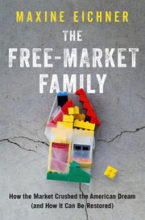 3. The Free-Market Family
by Maxine Eichner
3. The Free-Market Family
by Maxine Eichner
US families have been pushed to the wall. At the bottom of the economic ladder, poor and working-class adults aren’t forming stable relationships and can’t give their kids the start they need because of low wages and uncertain job prospects. Toward the top, professional parents’ lives have become a grinding slog of long hours of paid work. In this provocative book, Maxine Eichner argues that these very different struggles might seem unconnected, but they share the same root cause.
Read a free chapter here.
4. “Vote Choice and the Nonseparability of Economic and Social Issues” by Lukas F Stoetzer, Steffen Zittlau
Political issues are central to contemporary theories of democracy and political representation. Research on voting behavior often assumes that American voters hold distinct economic and cultural issue preferences. In this research note, Lukas F Stoetzer and Steffen Zittlau point out that this does not necessarily imply that preferences for candidates’ positions on the two issue dimensions are also additively separable in voters’ decisions.
5. Exit from Hegemony by Alexander Cooley and Daniel Nexon
We live in a period of great uncertainty about the fate of America’s global leadership. Many believe that Donald Trump’s presidency marks the end of liberal international order—the very system of global institutions, rules, and values that shaped the American international system since the end of World War II. Alexander Cooley and Daniel Nexon develop a new, integrated approach to understanding the rise and decline of hegemonic orders.
Read a free chapter here.
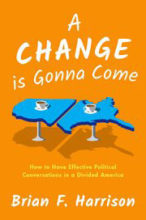 6. A Change is Gonna Come by Brian F. Harrison
6. A Change is Gonna Come by Brian F. Harrison
“Get your head out of your @*&. Snowflake. Stupid liberal. Ignorant conservative.” There is much discussion today about the decline in civility in American politics. How can deliberative democracy survive if we can’t even speak to people with whom we disagree? As this book argues, we need a new way to discuss politics, one that encourages engagement and room for dissent.
Read a free chapter here.
7. Never Trump by Robert P. Saldin and Steven M. Teles
As it became increasingly apparent that Donald Trump might actually become the Republican party’s 2016 presidential nominee, alarmed conservatives coalesced behind a simple, uncompromising slogan: Never Trump. Based on extensive interviews with conservative opponents of the president, Robert P. Saldin and Steven M. Teles reveal why such a wide range of committed partisans chose to break with their longtime comrades in arms.
Read a free chapter here.
8. “Does Issue Importance Predict Learning About Candidates?” by Joshua Robison
A long-standing argument is that policy voting is more likely on issues the voter considers subjectively important. However, existing evidence is highly mixed. Joshua Robinson leverages panel data from the 2008-2009 American National Election Studies (ANES) Panel to investigate the relationship between subjective issue importance and a key mechanism thought to link it and policy voting: candidate knowledge.
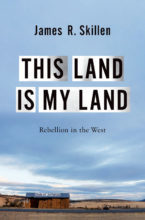 9. This Land is My Land
by James R. Skillen
9. This Land is My Land
by James R. Skillen
Anti-federal government sentiment has animated conservative politics in the West for decades upon decades. This book tells the story of conservative rebellion-ranging from legal action to armed confrontations-against federal land management in the American West over the last forty years.
Read a free chapter here.
10. The Ubiquitous Presidency by Joshua M. Scacco and Kevin Coe
American democracy is in a period of striking tumult. The clash of a rapidly changing socio-technological environment and the traditional presidency has led to an upheaval in the scope and standards of executive leadership. This book brings needed insight to this complex situation by offering the first comprehensive framework for understanding contemporary presidential communication in relation to the current socio-technological environment.
Featured image by FLY:D on Unsplash
The post Nine challenges that American democracy faces [reading list] appeared first on OUPblog.

April 1, 2021
Winner of Grove Music’s 2021 spoof article contest
It’s April Fool’s Day, which means the time has come to reveal the winner of the 20th anniversary edition of Grove Music Online’s Spoof Article Contest.
This year’s expert judges include:
Deane Root, Editor in Chief of Grove Music Online, and Professor of Music emeritus, Director and Fletcher Hodges, Jr. Curator of the Center for American Music, University of Pittsburgh, has been immersed in Grove style since he worked under Stanley Sadie on the first New Grove Dictionary of Music and Musicians.Musicologist Suzanne Cusick is the Samuel Rudin Professor in the Humanities at New York University and the most recent past president of the American Musicological Society. Shehas published extensively on gender and sexuality in relation to the musical cultures of early modern Italy and contemporary North America and has authored or coauthored 15 articles in Grove Music Online, including “Feminism in American Music.”Anna-Lise Santellais Senior Editor for Music Reference at OUP, a position that includes serving as publishing editor of Grove Music Online. She spends a lot of time with style guides and once read the 1927 edition of Grove cover-to-cover for fun.First, a heartfelt thank you to everyone who submitted an article. We have thoroughly enjoyed reading every one. This year’s crop of articles was truly exceptional and made the judges’ job especially hard.
Typically, we find some trends in our submissions that suggest some kind of Zeitgeist of humor and this year was no different. It was hard to miss that the biographies took a turn for the macabre, perhaps inevitable as we begin year two of a pandemic. Whereas our 2016 contest saw a surprising number of flatulence artists among its biographees, this year we saw an unprecedented attention to the mode of death. Some of the more notable included:
Arrhythmia (a drummer)Digititis (a pianist)Friendly fire, World War IHead injury due to a fall from an organ loftHit by a car (“it is believed accidentally”) driven by an audience member.While biographies made up the bulk of submissions, as they typically do, we were also treated to a number of articles on several theoretical topics. We would like to give a special acknowledgement to one of these, Ian Sapiro’s article on the Treksachord (from Kl. trek: ‘boldly go’, and Gk. chordē: ‘string’), which just missed the top three. Ian Sapiro is Associate Professor of Music of Stage and Screen at the University of Leeds and provided us with this stellar musical example of the chord in question:

For the first time in the history of the contest, our judges split three ways. After some internal squabbling rational, well-reasoned argument, we selected “Lip Synch” by Lisa Colton, Reader in Musicology and Director of Graduate Education at the University of Huddersfield. Although Colton’s article misses one key Grove style point—all Grove articles begin with a definition sentence that succinctly explains the subject—it made us laugh so long and so loud, that we feel it is indeed deserving of this great honor. “A quite clever and evocative parody of a performance practice article, replete with medieval terminology, Latin texts, and modern drag references,” noted Judge Root. Judge Cusick called it “an imaginative pseudo history of the performance practice as originating in a queerly illicit mix of ecclesiastically silenced nuns and the monks on the other side of many monastic institutions’ walls; parodies the ventriloquization of women in music studies, the quest for origins that drives a certain kind of musicology, the elision of technology that characterizes another kind of musicology and the elision of gender that characterizes still another kind. Needs only a mention of the theorist/practitioner of the genre, Lypsinka, whose name before monachization was John Epperson.”
Lip SynchThe popular origins of Lip Synch, or Lip Synchronization, lie in the violent Crumhorn Battles of early modern Flanders, but comparable practices can be found much earlier in northern Britain, probably arriving there with the Vikings during the tenth century. The socio-cultural impetus for combining the voice of one singer with the performance of another individual seems to have been in the exclusion of women from all vocal performance, especially in religious settings, between the edict of St Paul and the reversal of that rule by second wave feminists in 1965. Giraldus Cambrensis (De rebus a se gestis, c1204) provides the fullest description of what he termed labia simul: the Gilbertine nuns he visited at Shouldham in 1201 opened their mouths in unison, making the shapes of words, while the canons in the adjoining church provided the musical sounds themselves. Matins would begin each day with the cantrix intoning Psalm 69 (Vulgate), Domine, labia mea aperies (“O Lord, open my lips”), in secret, and thus the combined liturgical rituals would commence in a broadly synchronized fashion. The technical challenge presented by the wall separating the male and female chambers of Gilbertine houses was obviated by a revolving hatch, through which feedback from the cantor and cantrix would be exchanged with appropriate modesty. A handful of examples of their notes are extant, typically employing the high-status, Anglo-Norman vernacular. One such memorandum (now DRu-P.a.UL), dating to the Feast of the Circumcision, 1243, reads simply: “Chantez, restez”, with the appropriate liturgical response proper to the day, “Sachez awez”.
BibliographyP.J. Nixon: ‘Giraldus Cambrensis on Music: How Reliable are his Historiographers?’, Medieval Studies: Skara 1988, 264–89
Margolyes: Hildegard von Bingen and The Flaming Lips (Tunbridge Wells, 1983)
Visage: Lip Synchronization: A Surprising History (London, 2020)
Our first runner up “Bach-Bach Bach, Johann Egbert,” was submitted by conductor Andrew Gaydos. Although this article mostly follows Grove style, it misses a few of the finer points (life information should be in parentheses, not square brackets; the works list requires a heading). Nevertheless, Judge Santella, who is generally partial to chicken jokes that don’t involve dangerous road crossings, particularly liked the title and found herself repeating it out loud at odd moments, to the puzzlement of her feline home officemate. Judge Cusick thought it needed “a cross-reference to musica al cortile, which would bring in ducks and rabbits, after the fashion of pasta al cortile, served with a ragu of the animals kept in an Italian courtyard.” Judge Root deemed the article “Cleverly hatched, though the life’s effort ends beaten and fried.” He also observed that “The personal names and titles are inspired, building to my new favorite title for a work, the ‘Heißeundverschwitztpassion.’ The final work listed, ‘Kaltedusche chorales,’ is a splash of relief from the intensity of the ‘sacred works.’ This reader can also appreciate that the well-designed models of the catalog of works are appropriately Prussian.”
Bach Bach-Bach, Johann EgbertJohann Egbert Bach Bach-Bach [b Eiburg, Prussia 1755; d Bauernomelett, Prussia 1823] German musician and composer. Johann Egbert Bach Bach-Bach was the only son of Wilhelm Jacob Bach and his third-cousin Maria Johanna Bach-Bach. As Egbert was an only child, both parents felt it important that he would maintain both respective family lines. Note: there were other less-important musicians in the Bach family tree which do not merit references in this work.
He was trained by the local organist Markus Hühnerfuß. Herr Hühnerfuß was notoriously cruel often beating the fingers of his students if they made mistakes. Bach Bach-Bach reminisced that he often pulled his fingers away in just the nick of time. Bach Bach-Bach, mockingly, referred to his method as Hühnerspiel.
In 1774 he became the Kantor for the Valentinkirche in Bauernomelett. He worked with the poet Andreas Heiße who created a passion narrative between the four gospels later referred to as the Heißepassion. Bach Bach-Bach used additional libretti by the poets Max Tagesleiden and Ernst Welpenliebe as well as Pastor Johann Verschwitzt on later settings of the passion. He also rewrote a version using the chorales from the Heißepassion and the recitatives and soli from the Verschwitztpassion. This was later referred to as the Heißeundverschwitztpassion and premiered at the Valentinskircke during Lent of 1784.
He was constantly rewriting and reworking these texts. As his wife and 21 children can attest, there was a lot of passion in the Bach Bach-Bach household.
His works were catalogued by Otto Hahnrei and given a Bach Musik Werk number: BMW.
SACRED WORKS
BMW M1 Heißepassion, passion-cantata (1775)
BMW M3 Tagesleidenspassion, passion-oratorio (1779)
BMW Z4 Welpenliebepassion, passion-cantata (1780)
BMW M5 Verschwitztpassion, passion-oratorio (1782)
BMW X6 Heißeundverschwitztpassion, passion-oratorio-cantata (1784)
CHORALE SETTINGS
BMW i8 12 Kaltedusche chorales, chorale settings (1788)
And last, but certainly not least is the article which offered our favorite gratuitous table, “Connors-Williams Scale” by Jeremy Barham, Reader of Music at the University of Surrey. Judge Root observed, “Brilliant synthesis of pseudoacoustic theory and sports commentary. I was able to control myself until I came to Fig.1. Space limitations prevented citing a few more notable authorities including Evert and McEnroe. I mean, in my most frustrated moments listening to matches on television I can imagine this as real!”
Connors-Williams ScaleA musical scale defined by amplitude, pitch and syllabics, deriving from practices of high-pressure exhalation and laryngeal constriction common to competitive physical exertion (esp. tennis). First identified by Wills Moody (‘The Net Effect’, Daily Mail, July 23, 1936, ix) and variously termed ‘grunt- fest’, ‘lunge-mouth’, or ‘coup de gorge’, the scale was codified through applications of string perturbation theory and baseline experiments conducted from 1972 at CERN (Centre for the Exploration of Refractory Noise, Bagshot) using ATP test subjects (after two of whom the scale is named), multi- microphone capture of spatial audio, and pseudo-anechoic acoustic measurement through impulse response truncation methods (Seles, ‘Vocal Artistry in Tennis: an Empirical Investigation’, JAES, xxxvii/3, 1989, pp. 0–6; Sharapova, ‘Acoustic Laws of Musicalized Competitivity’, IJMSR, cxxxi, 2005, pp. 15–40). Building on Fechnerian psychophysical theories, in 2010 SQuEAL (Society for Quantitative Evaluation in Audiophonic Linguistics, Brisbane) standardized the scale’s logarithmic relationships between volume, pitch, duration, agogics and on-court position, length of continuous play, degree of peril, and quantity of tournament prize money (see ACOUSTICS, §VI).
Characterized by multiform hexachordal sets and micro-intervallic end-exchange operations (MIEEO) the scale has been adopted by experimental composers and sound artists in Europe and the USA as generative structural mechanism and aesthetic frame: Roger Dunlop, Thwack! (2006); Novak Slazenger, Lob des Herrn (2008); Rafael Björnson, Net Chords (2017).
Fig. 1. Simplified C-W scale graph with primary hexachordal fields (H ) and MIEEOs (*) indicatedBibliography
Barker, Boris, Musiker auf dem Tennisplatz: die Kunst und Wissenschaft der stimmlichen Vorteilsnehmigkeit (Musicologica Württembergiensia Band 31, Tübingen, 2018)
Murray, Juliana, ‘Racquet or Racket? The C-W Scale and the Music of the Competitive Mind’,
International Journal of Music and Sport Research cxxxiii (2007), 3–6, 5–7, 6–7
Congratulations to all! We will be contacting the winner about her prize shortly, but for the runners up, bragging rights are available immediately. And thank you to all of the contestants. We hope to see you all back here again next year.
The post Winner of Grove Music’s 2021 spoof article contest appeared first on OUPblog.

New discoveries about John Shakespeare: financial ruin and government corruption
A golden age for some, crooked and dishonest for others? Perhaps William Shakespeare grew up thinking this way about Elizabeth I and her ministers as disaster befell his father. Like thousands of others during Elizabeth’s reign, John Shakespeare’s business activities were denounced by well-connected informers linked to corrupt Exchequer officials. Once the queen had taken her cut, part of the profits went to privileged insiders who saw local men as easy targets. As documents recently discovered in the National Archives in London show, the resulting debts stalked the Shakespeare household for years.
In July 1569, John Shakespeare, then Bailiff of Stratford, sat on a jury at the session of Gaol Delivery in Warwick alongside one Chief Justice, a sergeant-at-law, and a fine array of local knights and gentlemen. It was probably the high point of his career. In popular culture, England in the 1570s is often portrayed as a time when Elizabeth I reigned over a nation grateful for deliverance from the turmoil experienced under her siblings, the boy king Edward VI and the implacably pious Mary I. Like so many historical commonplaces, it is far from the everyday reality. In the English Midlands political and religious division troubled many families, alongside that other great source of friction—money. For the aspirational John Shakespeare, the 1570s were not golden but tarnished by financial disaster and a social fall that haunted his son, William, whose later pursuit of gentle status is well-known.
John Shakespeare lent money at interest, usury that God-fearing Protestants had for years prohibited by law. He also bought and sold wool, a trade which the same lobby-groups had restricted to a privileged few but which was widely practiced by those, like John, who saw no reason why they should not also have a slice of this lucrative cake. For over a generation historians and Shakespeare scholars have used five Exchequer manuscripts dating from 1569 to 1573 to create the accepted account of the trouble that his business dealings brought to John. However, given that these troubles seem to have been resolved by 1573, some have also been increasingly insistent that his withdrawal from his Corporation duties after 1577 is evidence of a rediscovered Catholic conscience, relying on evidence that can tend towards wishful thinking.
As our research turned up an increasingly fractious and complex world in Warwickshire, and following a hunch suggested through long acquaintance with the foibles of the Exchequer documents in the National Archives in London, by 2018 we had uncovered over twenty new manuscript references to John Shakespeare among the Exchequer writ files. It was clear that in 1573, John Shakespeare’s troubles were only just beginning. Two cases and one man, the professional informer James Langrake, ensured that the Exchequer pursued John for debt into the next decade, by which time his business and credit were ruined and his son William a grown man. Alongside shady Exchequer officials who issued fake writs to entrap men like John Shakespeare, Langrake was part of a network that resisted all attempts to clean up the system. The new Exchequer documents show how deeply John Shakespeare was ensnared within it. As the name suggests, writs are written orders from institutions with legal powers, usually a court, and are still part of modern legal systems through documents such as subpoenas. In the 1570s and early 1580s, John Shakespeare was named on Exchequer writs sent to the sheriffs of Warwickshire who were nominally charged with chasing debtors. Those discovered mean that we now have documentary evidence that John’s financial problems started earlier and lasted longer than previously believed. The system was widely criticised and deeply divisive—in 1566, victims had even invaded Westminster Hall to berate and beat up prominent informers. Yet Parliamentary reformers found themselves continually stymied by a coalition of Exchequer bureaucrats, prominent members of the House of Commons, influential courtiers, and the monarch, who was easily persuaded that reform would intrude on her prerogative powers.
Ultimately nothing changed, and William Shakespeare grew up knowing that the government treated local men without influence in very different ways from the entrenched back-scratching of the Court and the Westminster bureaucracy. As so many of his plays attest, justice, power and corruption were never far from the creative imagination of a playwright who had experienced this uncertain world first-hand. For another Warwickshire family, the Ardens, resistance to the loss of influence through their political marginalisation meant the loss of more than credit. In 1583, indicted by a local jury that included men known to the Shakespeare family, the judicial murder of Edward Arden, a victim of Warwickshire’s cut-throat politics, meant that John Shakespeare may have counted himself lucky not to have lost more.
Featured image by Gabby K
The post New discoveries about John Shakespeare: financial ruin and government corruption appeared first on OUPblog.

March 31, 2021
From “trash” to “rubbish” and back to “trash” (part two)
Last week (24 March 2021), we tried to find out the origin of “trash.” Today, the turn of rubbish has come round. We’ll see that in the beginning, words for things wasted or thrown away tend to denote some concrete refuse and only later acquire a generic meaning. Yet, when several synonyms share the field, they are seldom fully interchangeable. Thus, trash, rubbish, junk, offal, and garbage either refer to different kinds of discarded objects or have different stylistic overtones. One also notices with some surprise that in Modern English, all such words are borrowings.
Except for Walter W. Skeat, the authors of other reliable dictionaries inform us that the origin of rubbish is unknown or uncertain, even though this word has been current since the fourteenth century. The fourteenth century means Middle English. To be sure, people never stop coining words, but, if rubbish had existed in Germanic since time immemorial, it would have had a different look. A loanword? Probably. But before trying to find the source of our word, we should decide whether it has anything to do with rubble.
 James Allanson Picton (1805-1889) and Hensleigh Wedgwood (1803-1891). (Images via Wikimedia Commons: left, right.)
James Allanson Picton (1805-1889) and Hensleigh Wedgwood (1803-1891). (Images via Wikimedia Commons: left, right.)To the public, etymology is an anonymous area of knowledge. Those who have heard the names of Walter W. Skeat, James A. H. Murray, and Ernest Weekley probably realize that those scholars did not single-handedly find the origin of all the words included in their dictionaries, even though their contributions must have been significant. The less famous figures, to whom the study of the English vocabulary owes so much, belong to history, as the phrase goes, and even professionals seldom refer to them. About a hundred and fifty years ago, James A. Picton, Abram Smythe Palmer, and especially Hensleigh Wedgwood were well-known to the public (the internet has preserved the images of Picton and Wedgwood, and I hope that Picton is still remembered not only in Liverpool). In the indispensable periodical Notes and Queries, we can find their conflicting views on the etymology of rubble and rubbish. Does this sound funny: opinions on rubbish? Not at all!
Picton insisted that rubbish and rubble are, from an etymological point of view, different words. Rubble, he argued, goes back to Old French robeus or robows, which refer to
“the stone chippings mixed with mortar used in Roman and medieval buildings to fill in the core of a thick wall… So far as my researches go, I can find no instance of rubble having any other meaning than that of undressed stone fragments or chippings. The derivation suggested by Mr. Wedgwood [in his dictionary] from French repous is a very probable one… I maintain, therefore, that rubble cannot, under any circumstances, be identified with rubbish.”
One can see that rubble has never changed its meaning. Picton may have had a point, but robeus looks suspiciously like rubbish. Also, the evidence at Picton’s disposal suggested to him that rubbish had appeared in English almost two centuries after rubble, but in fact, the two words are almost contemporaneous.
Murray and his circle treated Picton with the respect that scholar deserved, and perhaps the formulation on rubbish in the old OED owes something to him (mere guessing). In any case, we read there that rubbish is of obscure origin, though related in some way to rubble, but that there is no certainty that Anglo-Norman robel and ruble, the earliest attested English forms of rubble, are of French origin. Indeed, no one knows whether robeus, the supposed plural of robel, ever existed.
 Building demolished. (Image by Photomat.)
Building demolished. (Image by Photomat.)The other school was represented by Wedgwood and Smyth Palmer. I’ll skip their musings on chronology and quote Skeat, who, like those two scholars, insisted on the identity of rubble and rubbish and even defined rubbish as “broken stones, waste matter.” Skeat looked on Middle English robows, robeux as the plural of the unattested word robel, “clearly represented but Modern Engl. rubble.” Let us not forget that robel did not show up in any text, a circumstance that explains the OED’s caution. Skeat went on saying that rubble is obviously the diminutive of French robe “trash” and cites Italian roba, one of whose oldest senses was (alongside “gown” and “robe”) “trash.” Robaccia still means “old goods, rubbish,” and robiccia means “trifles, rubbish,” from robe. I have more than once noted in this blog that every time a researcher, even one of Skeat’s stature, says obviously, we are or may be in trouble. When everything is clear, there is no need to say “obviously.” And let me repeat for the third time: robel has not been attested. Now, it appears, we should look at rob and robe, but this part of the investigation can wait, because still another hypothesis on the origin of rubbish deserves our attention.
In 1946, Leo Spitzer, a distinguished Romance philologist and an astute word historian, pointed to the Old French reborser, familiar to English speakers from the word brush. The senses associated with reborser are, among others, “to brush the hair the wrong way; stem the tide” and “retrace one’s steps.” In one of the modern French dialects, rebroh and rebrost mean “an accumulation of tree branches, tree stumps,” the reference being to the debris in a forest. Let it be remembered that English brush “wood thicket,” quite possibly identical with brush “utensil,” another borrowing from French, which appeared in English in the same fourteenth century and meant “lopping of trees.” In British English, this noun seems to be relegated to regional speech, but in American and Canadian English, brush(wood) is a familiar word. This is Spitzer’s suggestion:
“The heap of debris to which rubbish originally referred was a pile not of stone [as is the case with rubble] but of branches, and the main idea was not that of worthlessness but of obstructiveness.”
 Both trash and rubbish? (Image by Richard Webb, cc-by-sa/2.0)
Both trash and rubbish? (Image by Richard Webb, cc-by-sa/2.0)Updating great dictionaries is slow and sometimes thankless work: no sooner a new entry seems to be ready for publication than someone comes up with another ingenious hypothesis. To exacerbate the situation, in most cases, several perfectly reasonable solutions compete. Did Spitzer guess well? In this blog post, I try to stay away from listing and evaluating multiple conjectures, which would inflate the posts to many pages and only bore the readers, but an important detail struck me in Spitzer’s reconstruction, and I decided to revive it. Those who happened to read the previous post may remember that the earliest meaning of trash was “broken twigs.” Spitzer, I suppose, did not connect rubbish (as he understood it) and trash, and hardly anyone else has noticed the similarity. I am not saying that the riddle has been solved, but it would be nice to arrive at a single semantic explanation for rubbish and trash. Rubble would then have its own etymology, though rubble and rubbish, close in sound and meaning, may or even must have influenced each other in the course of their long history. If we accept this result, Picton will be vindicated, though not for the reasons he cited. He wrote:
“The two words rubble and rubbish, which are continually confounded, have really nothing to do with each other. Their origin is different, and their meaning entirely separate.”
Rubble, rubbish, rub, rob, robe, riffraff… Do they all belong here?
To be continued.
Feature image by Leonid Danilov
The post From “trash” to “rubbish” and back to “trash” (part two) appeared first on OUPblog.

March 30, 2021
Government transparency and the freedom of information [podcast]
In 1967, the Freedom of Information Act (FOIA) was passed by the US Congress and signed into law by President Lyndon Johnson. Barring certain types of exemptions, the FOIA allows for American citizens to request access to records from federal agencies. Similar laws exist around the world, though each differ based on their respective countries’ political and cultural situations.
On our previous episode of The Oxford Comment, we talked about Open Access and the importance of the accessibility of academic research for the betterment of society. This episode, we are joined by Himanshu Jha, the author of Capturing Institutional Change: The Case of the Right to Information Act in India, and Vivien A. Schmidt, the author of Europe’s Crisis of Legitimacy: Governing by Rules and Ruling by Numbers in the Eurozone, to discuss government transparency and the flow of information from those in power to the citizens who ultimately give them power.
Please subscribe to The Oxford Comment through your favourite podcast app to listen to the latest insights from our expert authors.

Featured image by AbsolutVision ( CC0 via Unsplash).
The post Government transparency and the freedom of information [podcast] appeared first on OUPblog.

March 28, 2021
Do you know the hidden histories of these words? [Quiz]
Successful word-coinages—those that stay in lingual currency for a good, long time—tend to conceal their beginnings. In The Hidden History of Coined Words, author and word sleuth Ralph Keyes explores the etymological underworld of terms and expressions and uncovers plenty of hidden gems; knickers, for example, resulted from a hoax; big bang from an insult. Casual wisecracking produced software, crowdsource, and blog.
Surprised yet? Take our quiz and see how many hidden histories you know!
The post Do you know the hidden histories of these words? [Quiz] appeared first on OUPblog.

March 27, 2021
Giant hidden black hole discovered only 1.4 billion years after the Big Bang
Black holes are some of the most bizarre objects in the Universe but their existence is a robust prediction of the general theory of relativity of Albert Einstein. The discovery by Roger Penrose in the 1960s was honored with the Nobel Prize in Physics in 2020, along with the more recent discovery of Andrea Ghez and Reinhard Genzel of a giant black hole at the center of our Galaxy with a mass millions of times that of the sun.
Scientists have known for some time that much larger black holes with mass billions of times that of the sun existed as early as a few hundred million years after the Big Bang. The processes that led to the formation of such giant black holes that power the well-known population of quasars so early in the history of the Universe remain a mystery to theorists.
Scientists have also suspected for some time that a much larger population of these ancient giant black holes may be hidden by clouds of gas and dust that circle the black hole in a toroidal structure. These black holes can only be identified by the glow of infrared radiation from the toroidal structure that hides them. An international team of astrophysicists have discovered such a hidden giant black hole in a galaxy that existed only 1.4 billion years after the Big Bang. Over the past few year, the team of scientists has pursued a project called Herschel Extragalactic Legacy Project or HELP that put together the data from a number of telescopes, including ESA’s Hershel Space Observatory and NASA’s Spitzer Space Telescope, which observed the cosmos at infrared wavelengths. Infrared astronomy is especially difficult as the observations need to be carried out from space using telescopes that need to be cooled to a temperature close to -270 degrees Celsius.
One of the first areas of the sky analyzed by the HELP team was the Cosmological Evolution Survey (COSMOS) field, which is one of the best studied regions of the sky with an area about ten times that of the full moon. The galaxy that hosts the black hole is barely visible even in the deepest image of the COSMOS field taken by the Hubble Space Telescope, which can only observe the optical and ultraviolet emission of galaxies. What made the discovery of this black hole possible is that fact that it is much brighter at infrared wavelengths.
What is exciting about this discovery is that the COSMOS field where the galaxy that hosts the black hole was discovered is only a very small part of HELP. The HELP survey covers an area of the sky which is about 600 times larger. The team estimate that when the analysis of all the HELP data is complete a lot more of these hidden black holes will be found. The team, which was led by Professor Andreas Efstathiou of European University Cyprus, estimate that there may be at least as many hidden black holes as the ones we can see directly as luminous quasars.
Featured image by John Paul Summers
The post Giant hidden black hole discovered only 1.4 billion years after the Big Bang appeared first on OUPblog.

March 26, 2021
Top five OSO titles in Business and Management [reading list]
To celebrate the continuously expanding field of Business and Management, we reflect on some of the most popular topics researched by users of Oxford Scholarship Online this past year. Explore the collection and enjoy free access to chapters from our top five most visited titles, for a limited time.
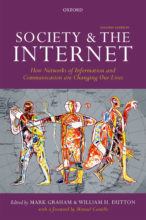 1. Society and the Internet edited by Mark Graham and William H. Dutton
1. Society and the Internet edited by Mark Graham and William H. Dutton
How is society being reshaped by the continued diffusion and increasing centrality of the Internet in everyday life and work? Drawing from a range of disciplinary perspectives, Internet research can address core questions about equality, voice, knowledge, participation, and power.
This free chapter explores the potential for digital media to have transformative and revolutionary effects on access to information, services, and global markets.
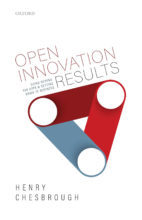 2. Open Innovation Results by Henry Chesbrough
2. Open Innovation Results by Henry Chesbrough
To get valuable results from innovation, businesses must open up their innovation processes and finish more of what they start. They need to open their knowledge flows to generate new growth, and unused internal knowledge must flow openly to others to generate new revenue and future business opportunities.
This free chapter reviews the core ideas behind Open Innovation, discusses what it is and is not, and shows how it can deliver more value to organizations and to society.
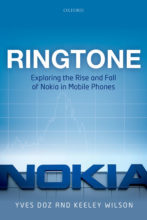 3. Ringtone by Yves Doz and Keeley Wilson
3. Ringtone by Yves Doz and Keeley Wilson
In less than three decades, Nokia emerged from Finland to lead the mobile phone revolution. It grew to have one of the most recognizable and valuable brands in the world and then fell into decline, leading to the sale of its mobile phone business to Microsoft.
This free chapter of Ringtone discusses this decline and looks at the options Nokia’s management team considered with regard to its smartphone strategy before ultimately choosing an alliance with Microsoft.
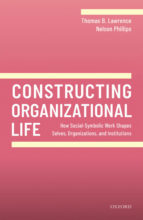 4. Constructing Organizational Life by Thomas B. Lawrence and Nelson Phillips
4. Constructing Organizational Life by Thomas B. Lawrence and Nelson Phillips
Across the social sciences, scholars are increasingly showing how people “work” to construct organizational life, including the rules and routines that shape and enable organizational activity, the identities of people who occupy organizations, and the societal norms and assumptions that provide the context for organizational action.
This free chapter introduces the social-symbolic work perspective and three key forms of social-symbolic work: self work, organization work, and institutional work.
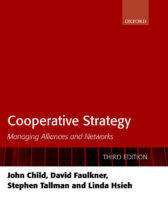 5. Cooperative Strategy by John Child, David Faulkner, Stephen Tallman, and Linda Hsieh
5. Cooperative Strategy by John Child, David Faulkner, Stephen Tallman, and Linda Hsieh
Cooperation has become the leading strategy adopted by business and other organizations. It is taking on new forms that are adapted to changing market expectations and technological possibilities in the rapidly evolving business environment.
This free chapter describes the contributions of managerial and organizational perspectives, such as strategic management theory, game theory, and organization theory, to the understanding of cooperative strategy.
Featured image via Pixabay
The post Top five OSO titles in Business and Management [reading list] appeared first on OUPblog.

March 25, 2021
Swine fevers: how to prevent and control the spread [infographic]
With the world’s attention set on the COVID-19 pandemic, concerns have been growing over the lack of concentrated efforts in preventing the current spread of swine fevers. Both Classical Swine Fever (CSF) and African Swine Fever (ASF) cause high mortality in pigs but are the result of two unrelated viruses and, if safe and efficacious prevention methods are not present, can cause significant socioeconomic impacts in endemic countries.
CSF was the most devastating disease of swine in the US between 1830 and 1970. According to USDA’s historical data, “outbreaks in 1886, 1887, and 1896 each killed more than 13% of the Nation’s hogs, and the disease was still costing producers $50 million a year in the early 1960s. By 1978, the US had eradicated CSF. So why haven’t other countries followed?
Large pork-producing countries such as China, Vietnam, Thailand, Japan, South Korea, and the Philippines still do not have control of CSF and see significant loss of swine as a result. Whilst these countries have produced and had access to affordable and safe vaccines, science and technology simply is not enough to prevent the disease. The partnership of stakeholders and the public, brought together by government, is an integral part of prevention and control.
ASF and CFS share similar clinical symptoms in swine, but are caused by two unrelated viruses. There are significant knowledge gaps on ASF and as a result there is not currently a commercial vaccine for the disease. Without the presence of a vaccine, it was soon realized that swine producers would need to improve biosafety and biosecurity measures to reduce the spread of the disease. ASF was eradicated in most parts of Europe in the 1990s, however, many countries across Asia are still experiencing outbreaks today.
How can the goal of having “safe and efficacious” prevention methods be achieved? A new study detailed in Animal Frontiers, a journal from the American Society of Animal Science,suggests that knowing your enemy (the disease and pathogen), through supporting innovative research, will contribute to the development and implementation of science-based governmental policies. These policies will be most effective if stakeholders in the swine industry are involved in the development, which in turn will support cooperation. Ultimately, due to the transboundary nature of the disease, the adoption of policies on a global scale, and their effective coordination between countries, will be key for the implementation of successful prevention methods.
Explore the infographic below to find out more.

Take a further look into this topic with related articles from Animal Frontiers:
“How two concurrent pandemics put a spoke in the wheel of intensive pig production”, by Sam Millet, Sarah De Smet, Egbert F Knol, Giuseppe Bee, Paolo Trevisi, Stafford Vigors, Katja Nilsson, and Jef Van Meensel. (Animal Frontiers, Volume 11, Issue 1, January 2021, Pages 14–18.)“Effect of COVID-19 on animal breeding development in China and its countermeasures”, by Yaqiong Ding, Chengyu Wang, Liuqin He, Yulong Tang, and Tiejun Li. (Animal Frontiers, Volume 11, Issue 1, January 2021, Pages 39–42.)The post Swine fevers: how to prevent and control the spread [infographic] appeared first on OUPblog.

Oxford University Press's Blog
- Oxford University Press's profile
- 238 followers



